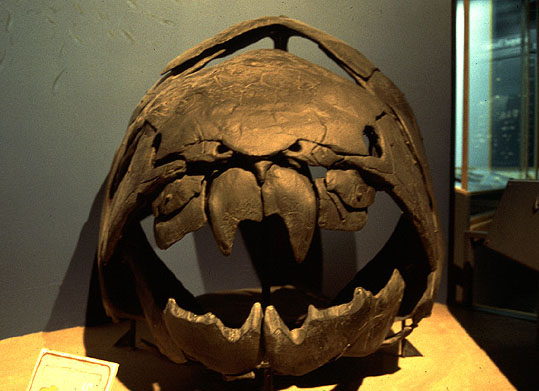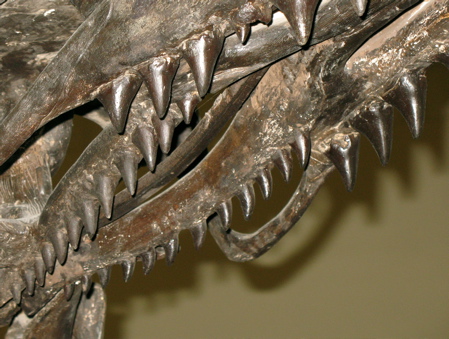Ever found a blog or website that is too good to be true? I have found this blog to be a very interesting blog, worthy of much attention. The posts are meaty and informative. So while I am being a little tardy in writing in my own blog, you can enjoy the very informative and interesting blog posts in this blog.
The specific article that I wish to highlight is one on the absolutely amazing spitting cobras. This post will intrigue you, 100 % guaranteed or your money back.
Labels
awesome
(9)
paleontology
(9)
Paleobiology
(8)
dinosaurs
(7)
marine biology
(5)
Art
(4)
Why Paleontology is Awesome
(4)
biology
(4)
ocean
(4)
sharks
(4)
biomechanics
(3)
crocodiles
(3)
drawing
(3)
painting
(3)
paleo-art
(3)
General
(2)
Montana
(2)
herpetology
(2)
ichthyology
(2)
pterosaurs
(2)
snakes
(2)
C.M. Russell
(1)
Elasmobranchs
(1)
Spinosaurus
(1)
Western
(1)
What is in the Works
(1)
buffalo
(1)
history
(1)
iceburg
(1)
mosasaur
(1)
ships
(1)
watercolors
(1)
Monday, April 27, 2015
Thursday, April 23, 2015
What Is In the Works.
Spring is here in the Flathead Valley! I will tell you what, spring in
NW Montana is wonderful in and of itself but it is even more wonderful
after months of winter. But spring is also the time of year to get
things done and preparing for the coming year. That means that quality
time with the computer and therefore with my blog becomes limited,
between work and getting things prepared at home (spring cleaning anyone?). We are hoping to be
raising a variety of poultry; we have 5 turkey already and some chickens possibly on their way.
It has been too long since I last wrote for this blog but I am slowly preparing future posts. One will be about one the most important figures in dinosaur paleontology and another will be about an armored
fish that had one of the most powerful bites in the animal kingdom.
So, in short, I have not abandoned this blog and will be writing in the future. Thank you for your patience.
It has been too long since I last wrote for this blog but I am slowly preparing future posts. One will be about one the most important figures in dinosaur paleontology and another will be about an armored
fish that had one of the most powerful bites in the animal kingdom.
 |
| A future post will be about this guy... |
 |
| and this guy. |
Tuesday, April 7, 2015
Artist Highlight: Raul Martin
 |
| The giant crocodylian Dienosuchus attacking a tyrannosaur. |
Raul Martins interpretation of dinosaurs, I think, has not been matched by many artists, as far as behavior and anatomy. His dinosaurs are balanced, lack any outlandish coloration and soft tissue add-ons. Their behavior is realistic and not fanciful. I am sure that the soft-tissue of dinosaurs could have been extreme and that their behavior could have been interesting to say the least but often, from what I have seen of some paleo-artists, sometimes the animals just are a little odd and outlandish to me.
To be honest, I really don't know anymore than that about Raul Martin. I have been unable to find any good biography about him anywhere. Here is his website, enjoy
 |
| This was done with pencil! |
Wednesday, April 1, 2015
Mosasaurs: Serpents of the Sea. W.P.A Post #2
After writing the last post for the Why Paleontology is Awesome series I had a bit of a dilemma. I just could not get away from pterosaurs!!! Now, that really isn't much of a problem but I needed to pick a different topic for the next post in the series. I really do not want to have a long string of pterosaur posts but they are just SO COOL! I have come to the singular conclusion that there is no such thing as a "normal" pterosaur. They all are unique and bizarre.
 But I have forced myself away from the leathery-winged areo-beasts and will now be writing about everyone's favorite sea-monster (other than sharks)- the Mosasaurs.
But I have forced myself away from the leathery-winged areo-beasts and will now be writing about everyone's favorite sea-monster (other than sharks)- the Mosasaurs.
Mosasaurs were serpentine reptiles that once inhabited the oceans worldwide. They came in many sizes and just as many varieties. They are known from every continent on the earth including Antarctica. They also were some of the very first fossil reptiles that were brought to scientific attention. Their fossils were found and described before the first dinosaur (Megalosaurus) was. It was originally thought to be a whale or a crocodile until some of the biggest names in paleontology at the time affirmed it to be a animal previously unknown some years later. The mosasaur was christened Mosasaurus hoffmanii meaning meuse-river reptile, after a local river, and was given the species name after the doctor that first gave interest in the animal. Mosasaurs were found by Lewis and Clark during their exploration of the west while trekking through Kansas. Other mosasaurs were found during other explorations of the West, including one by the German prince Maximilian von wien.
A lot has happened since the first mosasaurs were discovered. Several new species of mosasaur have been found since, many from around the globe. Many finds including well preserved soft-tissue such their wind pipe, skin, even internal organs and remnants of waste from the intestinal tract!
They fed on just about anything in the sea. Their meals included fish, mollusks, sharks, plesiosaurs, pterosaurs, birds, and other mosasaurs, so basically everything around them. Their style of eating might have been somewhat unique. Certain parts of their jaws were unfused and allowed disconnection. This would have allowed mosasaurs to eat food material larger than their heads. It is possible that after capturing their prey they would have arranged the food matter head first towards their stomach. They would then push it into their throat with their lower jaws, their lower jaws flexing at certain areas to allow this to happen. When the lower jaw was flexed as far is it could, the mosasaur's pterygoid teeth would
"catch" the food to keep it from escaping out of the mouth. It would then return its lower jaw to its natural position and repeat. I personally think that they would have incorporated a wide range of feeding behavior but may have incorporated the above method as its default method.
Mosasaurs hunting style has been traditionally viewed as an ambush predator that would be limited to short bursts being inefficient at long-distance pursuits. Well, one thing that I have learned about paleobiology is this: Whenever scientist limit an animal because it probably wasn't well designed for whatever, they turn out to be wrong. Tyrannosaurus rex is a good example of this. There was a time when it was popular to say that T. rex was an obligatory scavenger, like a modern-day vulture. Of course, today that idea is no longer seriously considered. It has since become apparent that T. rex was an active hunter. Also, we learned last W.P.A. post that pterosaurs were not as weak and helpless as once thought. Well mosasaurs are no exception. Recent finds and studies, such as this one and this one, have shown that mosasaurs may have been better sustained swimmers after all.
Some of the features that would have allowed them to be good, long-distance swimmers would have included scales that would have encourage better aerodynamics (for some reason I do not think that is the right word), bundles of fiber that would have been under the epidermis that would have kept the skin from folding when bending which would thus reduce drag, and a dorsal vertebrae column, or the back, that was rigid while the tail was the main source for propulsive thrust. Some have even suggested that certain species of mosasaurs would have swam like a plesiosaur or penguin, utilizing underwater flight for better maneuverability in weedy enviroments. I am not too sure of that hypothesis but it is worth looking into. All of this paints a rather fearsome picture of a very well-designed aquatic predator.
But just when you thought that the rivers would have been safe (although, with crocodiles the size of school buses swimming all around you probably would not have come to that conclusion), there were mosasaurs that seemed to enjoy freshwater. Mosasaurs seem to have been just about everywhere, from Antarctica to the Arctic, N. America to Australia and even in your lakes as well.
Now when I say that mosasaurs would have eaten everything, I meant just that. There were some
varieties that snacked on hard-shelled mollusks, like clams and muscles, ammonites, and even turtles. An example of that is Globidens. As evident by their name, their teeth were globular, perfect for crushing the hard shells. Stomach contents have even been found from Globidens shows that Globidens did in fact eat animals that were covered by hard shells. It was a large animal, attaining lengths of around 20 feet (~ 7m) long. Other mosasaurs like Globidens have been found, some did not have such extreme dentition, while others were just as unusual.
Mosasaurs were not social creatures at all! The fossils found with mosasaur in association with one another are either a "gravid" or, by more familiar terms but scientifically inaccurate, pregnant mother or a mosasaur is the stomach contents of another. So in other words, mosasaurs got together either for reproduction or to eat one another. Friendly animals, no doubt. Michael Everhart in Oceans of Kansas writes a list of all the mosasaurs that he is aware of (and he is aware of a lot of mosasaurs!) that were found together and they are examples of either babies prior to birth or one mosasaur ate the other one.
Mosasaurs gave birth to live young in a similar manner to snakes today. Sometimes you will see illustration of a mosasaur crawling on the beach to lay eggs like sea-turtles do but that is contrary to what we know about mosasaurs. They definitely gave birth to live young like many marine reptiles did in the past. It seems like that for many marine reptiles it was very common for them to give birth to live young instead of the typical reptilian mode of reproduction, namely laying eggs. Mosasaurs most likely would not have had any parental inclinations however. There are no reptiles today that do other than crocodilians which will often bring their babies to water and protect them. After a while though, those babies are on their own and if they were not careful, they may have become lunch for mother.
One topic that I have not found anybody to be interested in, or at least from what I can find, concerning mosasaurs, except for a very brief reference in a fictitious story, is that of their metabolic physiology. Were mosasaurs warm-blooded or cold-blooded? I have not really formulated an opinion myself except to assume for now that they were cold-blooded. Reptiles are, for the most part, ectothermic or in other words, cold-blooded. It is probably on the safe side to assume that of mosasaurs until the evidence proves otherwise.
Sharks are all ectothermic and yet the live an active life-style in the ocean. The physical demands for living in the weightless environment of water is significantly less than that on land. Being relatively active in the water is possible for sustained periods while running on anaerobic power, especially if you are as aerodynamic as a shark or a mosasaur. But I will not be conclusive in such conclusions until I can do more research on the subject.
Well, hopefully you have an appreciation for mosasaurs after this article. The work that goes into understanding something that is interesting is very rewarding and how much more it is when you study something AWESOME... like a mosasaur. Mosasaurs were truly very amazing beasts that demand our attention beyond what they may get this June...
 But I have forced myself away from the leathery-winged areo-beasts and will now be writing about everyone's favorite sea-monster (other than sharks)- the Mosasaurs.
But I have forced myself away from the leathery-winged areo-beasts and will now be writing about everyone's favorite sea-monster (other than sharks)- the Mosasaurs.Mosasaurs were serpentine reptiles that once inhabited the oceans worldwide. They came in many sizes and just as many varieties. They are known from every continent on the earth including Antarctica. They also were some of the very first fossil reptiles that were brought to scientific attention. Their fossils were found and described before the first dinosaur (Megalosaurus) was. It was originally thought to be a whale or a crocodile until some of the biggest names in paleontology at the time affirmed it to be a animal previously unknown some years later. The mosasaur was christened Mosasaurus hoffmanii meaning meuse-river reptile, after a local river, and was given the species name after the doctor that first gave interest in the animal. Mosasaurs were found by Lewis and Clark during their exploration of the west while trekking through Kansas. Other mosasaurs were found during other explorations of the West, including one by the German prince Maximilian von wien.
 |
| An engraving of the first mosasaur found. |
Mosasaurs were apex predators in the oceans that they thrived in. The rock layers that contain mosasaurs contain few to no other large carnivores suggesting mosasaur dominance wherever they went. They reached sizes few other predatory animals have reached, the largest mosasaur being up to 17m (~55 feet) long!
 |
| Mosasaur skin impression. |
"catch" the food to keep it from escaping out of the mouth. It would then return its lower jaw to its natural position and repeat. I personally think that they would have incorporated a wide range of feeding behavior but may have incorporated the above method as its default method.
 |
| Pterygoid teeth of a mosasaur |
Some of the features that would have allowed them to be good, long-distance swimmers would have included scales that would have encourage better aerodynamics (for some reason I do not think that is the right word), bundles of fiber that would have been under the epidermis that would have kept the skin from folding when bending which would thus reduce drag, and a dorsal vertebrae column, or the back, that was rigid while the tail was the main source for propulsive thrust. Some have even suggested that certain species of mosasaurs would have swam like a plesiosaur or penguin, utilizing underwater flight for better maneuverability in weedy enviroments. I am not too sure of that hypothesis but it is worth looking into. All of this paints a rather fearsome picture of a very well-designed aquatic predator.
But just when you thought that the rivers would have been safe (although, with crocodiles the size of school buses swimming all around you probably would not have come to that conclusion), there were mosasaurs that seemed to enjoy freshwater. Mosasaurs seem to have been just about everywhere, from Antarctica to the Arctic, N. America to Australia and even in your lakes as well.
Now when I say that mosasaurs would have eaten everything, I meant just that. There were some
 |
| Globidens dakotensis |
Mosasaurs were not social creatures at all! The fossils found with mosasaur in association with one another are either a "gravid" or, by more familiar terms but scientifically inaccurate, pregnant mother or a mosasaur is the stomach contents of another. So in other words, mosasaurs got together either for reproduction or to eat one another. Friendly animals, no doubt. Michael Everhart in Oceans of Kansas writes a list of all the mosasaurs that he is aware of (and he is aware of a lot of mosasaurs!) that were found together and they are examples of either babies prior to birth or one mosasaur ate the other one.
Mosasaurs gave birth to live young in a similar manner to snakes today. Sometimes you will see illustration of a mosasaur crawling on the beach to lay eggs like sea-turtles do but that is contrary to what we know about mosasaurs. They definitely gave birth to live young like many marine reptiles did in the past. It seems like that for many marine reptiles it was very common for them to give birth to live young instead of the typical reptilian mode of reproduction, namely laying eggs. Mosasaurs most likely would not have had any parental inclinations however. There are no reptiles today that do other than crocodilians which will often bring their babies to water and protect them. After a while though, those babies are on their own and if they were not careful, they may have become lunch for mother.
 |
| Mosasaur species found in the Midwest U.S.A |
One topic that I have not found anybody to be interested in, or at least from what I can find, concerning mosasaurs, except for a very brief reference in a fictitious story, is that of their metabolic physiology. Were mosasaurs warm-blooded or cold-blooded? I have not really formulated an opinion myself except to assume for now that they were cold-blooded. Reptiles are, for the most part, ectothermic or in other words, cold-blooded. It is probably on the safe side to assume that of mosasaurs until the evidence proves otherwise.
Sharks are all ectothermic and yet the live an active life-style in the ocean. The physical demands for living in the weightless environment of water is significantly less than that on land. Being relatively active in the water is possible for sustained periods while running on anaerobic power, especially if you are as aerodynamic as a shark or a mosasaur. But I will not be conclusive in such conclusions until I can do more research on the subject.
Well, hopefully you have an appreciation for mosasaurs after this article. The work that goes into understanding something that is interesting is very rewarding and how much more it is when you study something AWESOME... like a mosasaur. Mosasaurs were truly very amazing beasts that demand our attention beyond what they may get this June...
Subscribe to:
Comments (Atom)



.jpg)